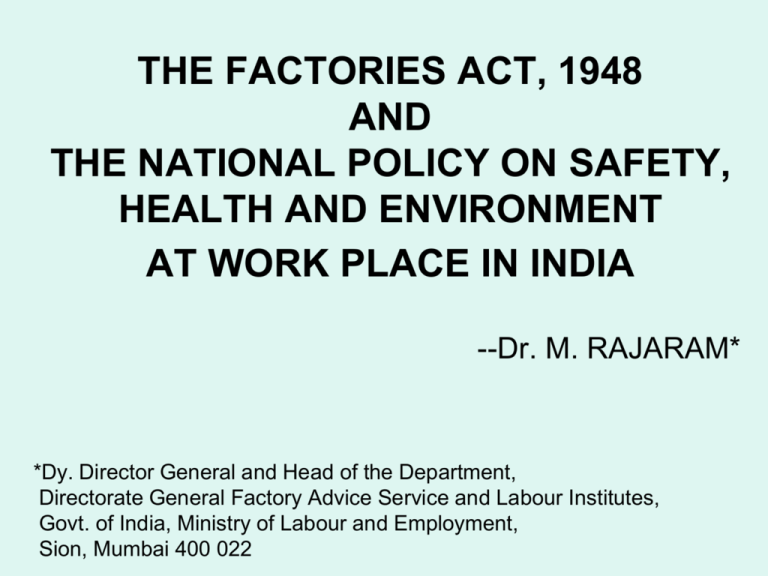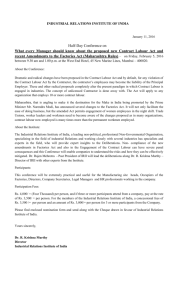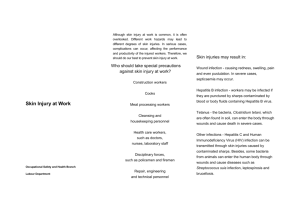the factories act, 1948 and the national policy on safety, health and
advertisement

THE FACTORIES ACT, 1948 AND THE NATIONAL POLICY ON SAFETY, HEALTH AND ENVIRONMENT AT WORK PLACE IN INDIA --Dr. M. RAJARAM* *Dy. Director General and Head of the Department, Directorate General Factory Advice Service and Labour Institutes, Govt. of India, Ministry of Labour and Employment, Sion, Mumbai 400 022 INTRODUCTION : • The Constitution of India has detailed provisions for the rights of the citizens and lays down the Directive Principles for securing the health and strength of employees and humane conditions of work • On the basis of these Directive Principles Government of India is committed to regulate all economic activities for management of safety and health of every working man and woman in the country. • The formulation of policy, priorities and strategies in OSH at work places, is undertaken by National Authorities in consultation with social partners for fulfilling such objectives. Contd…. THE FACTORIES ACT, 1948 * The Factories Act, 1948, is a central enactment, deals with occupational health and safety as well as welfare of workers employed in a factory. * The Act is enforced by the Factory Directorates under the State Governments and the administration of Union Territories.(UT) * The Ministry of Labour and Employment (MOL&E)in the Central Government is accountable to Parliament for ensuring uniform application of the Act throughout the country by issuing model rules to be adopted by the State Government and Union Territories with necessary modifications to suit local needs. Contd…. * Ministry of Labour & Employment also ensures coordination of activities of the State Factories Directorates through its technical organization Directorate General Factory Advice Service and Labour Institutes (DGFASLI). * The Act empowers the State Governments to declare any process or operation as dangerous and to ensure protection of persons employed in the operation or in the vicinity. * The Factory Rules lay down detailed instructions regarding preventive measures, protective devices, cautionary notices as well as medical examination of workers. Contd…. The Act list 29 Industries involving hazardous process, Permissible Levels of certain chemicals substances in the work environment of(116 Chemicals and their compounds), List of 29 Occupational Diseases. The act was comprehensively amended in 1987 in respect of hazardous processes with salient features as: * * * * * * Constitution of site appraisal committee, Compulsory disclosure of information by occupier, Medical examination of workers exposed to hazardous processes, Laying down permissible limits of exposure of chemical substances, Participation of workers on safety and health management, Right of workers to warn about imminent dangers. Contd…. THE SALIENT FEATURES OF THE FACTORIES ACT, 1948 • • • • • • • • • • • • • Chapter 1: Preliminary Chapter II: The Inspecting Staff Chapter III: Health Chapter IV: Safety Chapter IV-A: Provisions relating to hazardous processes Chapter V: Welfare Chapter VI: Working hours of Adults Chapter VII: Employment of young persons Chapter VIII: Annual leave with wages Chapter IX: Special provisions Chapter X: Penalties and Procedures Chapter XI: Supplemental THE FIRST SCHEDULE : List of industries involving hazardous processes • THE SECOND SCHEDULE : Permissible levels of certain chemical substances in work environment • THE THIRD SCHEDULE : List of notifiable diseases Contd…. STATUS OF OSH IN INDIAN INDUSTRIES Industrial Injuries from 2000 – 2007(P) Frequency Rate (FR) Incidence Rate (IR) Year Fatal Injuries Total Injuries Fatal Injuries Total Injuries Fatal Injuries Total Injuries 2000 486 23976 0.07 3.6 0.22 10.93 2001 627 28364 0.07 3.24 0.19 8.67 2002 540 20453 0.13 4.88 0.16 6.14 2003 525 16432 0.08 2.50 0.11 3.33 2004 562 15020 0.05 1.33 0.08 2.21 2005 613 14776 0.05 1.27 0.09 2.06 2006 1068 19912 0.08 1.42 0.13 2.41 2007(P) 821 15290 0.09 1.73 0.10 1.91 P: Provisional Source : Labour Bureau, Shimla. The coverage remains limited and varies from year to year because all the states/UTs are not submitting annual returns regularly. THE NATIONAL POLICY ON SAFETY, HEALTH AND ENVIRONMENT AT WORK PLACE * The National Policy on Safety, Health and Environment at Work Place was declared by Government of India on the 20th February, 2009 at New Delhi during the Indian Labour Conference. The main objective and goal of this National Policy is : * to eliminate the incidences of work related injuries, diseases, fatalities, to mitigate disasters and to protect national assets * to enhance the well being of the employees and society at large. * The Government of India firmly believes that building and maintaining a National Preventive Safety and Health Culture needs to be developed in close involvement of the social partners to meet the challenges ahead in the assessment and control of work place risks by Contd…. mobilizing local resources IMPLEMENTATION OF THE NATIONAL POLICY BY INVOLVING SOCIAL PARTNERS * * * * * * * * * . Providing an effective enforcement mechanism Building a national occupational safety & health profile Carrying out a national occupational disease profile Carrying out research and development in the field of OSH Ensuring suitable accreditation mechanism to recognize institutions, professional and services Providing a system of incentives to employer and employees to achieve higher health and safety standards. Increasing awareness on safety, health and environment through appropriate means Suitably incorporating teaching inputs on safety, health and environment at work place in schools, technical, medical, professional and vocational courses and distance education programme Data collection Contd…. CONCLUSION * The Government of India is committed to implement the National Policy on Safety, Health and Environment at Work Place through tripartite consultations and mobilization of available resources and expertise of all concerned stake holders. Contd…. THANK YOU







